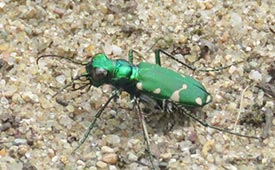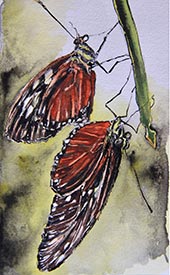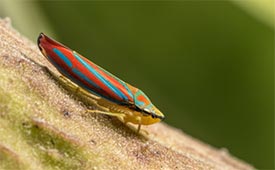Insects have a PR problem

Northern barrens tiger beetle (Photo by Dan MacNeal, CC BY 4.0)
It's time we change that.
You may have heard rumblings in the news about the loss of insects around the world. While some scientists have been screaming about this from the rooftops, it doesn’t seem to get the widespread attention it deserves. What’s more, human survival is dependent on the survival of insects. So why isn’t it sticking?

"Double Flutter" (By Leanne Cadden, ink and watercolour wash)
Well, for starters, insects have a public relations problem. Sadly, many people think insects are boring, gross or even scary. But they’re actually the unsung heroes of our planet. They play an important role in our food web, as they ensure the health of our soil and carry out vital tasks like pollination, pest control and the recycling of organic matter. But they can be pretty hard to relate to. We often anthropomorphize animals, meaning we attribute human characteristics like emotions to them to help us relate to them (think of Jiminy Cricket and Charlotte’s Web). But that can be hard to do with insects because their physiology and entire existence is so complex and different from our own.
Flagship species
Mammals often take centre stage when it comes to the plight of nature. Think about it. Which animal comes to mind when you think of melting ice in the Arctic? You probably thought about polar bears. What about wildfires in Australia? Did koalas come to mind? How about deforestation in Southeast Asia? Did you think of orangutans? These are just a few examples of flagship species, where an important animal becomes the face of a larger environmental issue. But not all insects are ignored. Bumble bees, for example, are symbolic of the pollination problem and food security while monarch butterflies symbolize a myriad of conservation issues.
But what about less beautiful or cute insects like beetles, ants and crickets, who are equally as important and are also facing threats? How can we get people to care about them?
Conservation psychology and the value of insects
One way to help people connect to and appreciate insects is by drawing on conservation psychology. While this field is centred on understanding human care for nature, it goes even deeper. As humans, we rely on nature to provide for us physically, mentally and emotionally. After all, we are a part of nature, not apart from nature. In a nutshell, conservation psychology illuminates this circular relationship where we care for nature and nature cares for us, according to this study from the Journal of Insect Conservation.
In a perfect world, we’d hope that people would value insects for their own worth. But our ability for empathy and caring is often linked to satisfaction. Whether connected to human well-being, the economy, medicine, agriculture or even pest control, this study from Biological Conservation suggests that appreciation for insects should be framed as essential and ethical. After all, understanding and caring for something often leads to action. The study also makes an interesting suggestion for messaging. It argues that we must convey how “appreciation and conservation of insects is now essential for our future survival” as our destinies are undoubtedly intertwined.
So how can we achieve this?

Leafhopper (Photo by Mariusz Dabrowski on Unsplash)
Part of the issue is that we are far more disconnected from nature than our ancestors. That’s why there’s a growing movement to reconnect with nature. This presents opportunities for people to experience it up close, especially in childhood. And insects are the perfect guide since they are all around us. There are any number of species of caterpillars, butterflies, beetles, ants and more roaming our backyards, parks and communities.
You can also become a citizen scientist yourself by counting species and/or uploading your insect pictures to apps like iNaturalist. Our love of photography and social sharing also presents another opportunity. Just look at all the many insect-themed hashtags on Instagram, like #bugstagram, #instabug or #insectsofinstagram (among many others). Or perhaps we need to channel the flagship species strategy by framing less loveable insects like dung beetles as the poster child for larger environmental issues like soil degradation. Also, turning to the arts is always a great idea. This breathtaking animation beautifully illustrates the flight of the bumble bee.
This post originally appeared on the National Environmental Treasure’s website and is reposted with permission.


